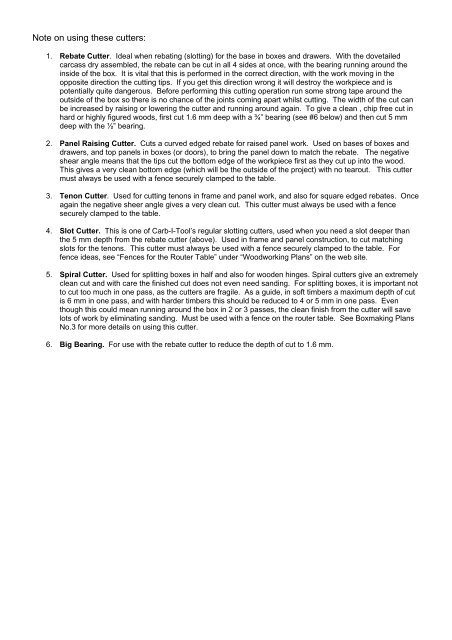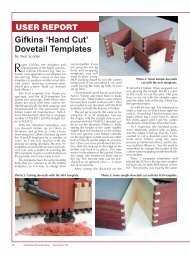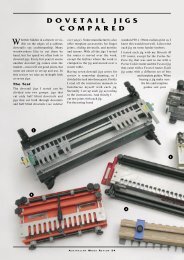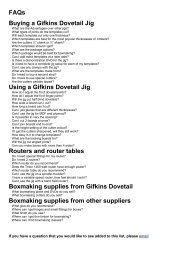Boxmaking cutters from Gifkins Dovetail - Gifkins Dovetail Jig
Boxmaking cutters from Gifkins Dovetail - Gifkins Dovetail Jig
Boxmaking cutters from Gifkins Dovetail - Gifkins Dovetail Jig
Create successful ePaper yourself
Turn your PDF publications into a flip-book with our unique Google optimized e-Paper software.
Note on using these <strong>cutters</strong>:<br />
1. Rebate Cutter. Ideal when rebating (slotting) for the base in boxes and drawers. With the dovetailed<br />
carcass dry assembled, the rebate can be cut in all 4 sides at once, with the bearing running around the<br />
inside of the box. It is vital that this is performed in the correct direction, with the work moving in the<br />
opposite direction the cutting tips. If you get this direction wrong it will destroy the workpiece and is<br />
potentially quite dangerous. Before performing this cutting operation run some strong tape around the<br />
outside of the box so there is no chance of the joints coming apart whilst cutting. The width of the cut can<br />
be increased by raising or lowering the cutter and running around again. To give a clean , chip free cut in<br />
hard or highly figured woods, first cut 1.6 mm deep with a ¾” bearing (see #6 below) and then cut 5 mm<br />
deep with the ½” bearing.<br />
2. Panel Raising Cutter. Cuts a curved edged rebate for raised panel work. Used on bases of boxes and<br />
drawers, and top panels in boxes (or doors), to bring the panel down to match the rebate. The negative<br />
shear angle means that the tips cut the bottom edge of the workpiece first as they cut up into the wood.<br />
This gives a very clean bottom edge (which will be the outside of the project) with no tearout. This cutter<br />
must always be used with a fence securely clamped to the table.<br />
3. Tenon Cutter. Used for cutting tenons in frame and panel work, and also for square edged rebates. Once<br />
again the negative sheer angle gives a very clean cut. This cutter must always be used with a fence<br />
securely clamped to the table.<br />
4. Slot Cutter. This is one of Carb-I-Tool’s regular slotting <strong>cutters</strong>, used when you need a slot deeper than<br />
the 5 mm depth <strong>from</strong> the rebate cutter (above). Used in frame and panel construction, to cut matching<br />
slots for the tenons. This cutter must always be used with a fence securely clamped to the table. For<br />
fence ideas, see “Fences for the Router Table” under “Woodworking Plans” on the web site.<br />
5. Spiral Cutter. Used for splitting boxes in half and also for wooden hinges. Spiral <strong>cutters</strong> give an extremely<br />
clean cut and with care the finished cut does not even need sanding. For splitting boxes, it is important not<br />
to cut too much in one pass, as the <strong>cutters</strong> are fragile. As a guide, in soft timbers a maximum depth of cut<br />
is 6 mm in one pass, and with harder timbers this should be reduced to 4 or 5 mm in one pass. Even<br />
though this could mean running around the box in 2 or 3 passes, the clean finish <strong>from</strong> the cutter will save<br />
lots of work by eliminating sanding. Must be used with a fence on the router table. See <strong>Boxmaking</strong> Plans<br />
No.3 for more details on using this cutter.<br />
6. Big Bearing. For use with the rebate cutter to reduce the depth of cut to 1.6 mm.







